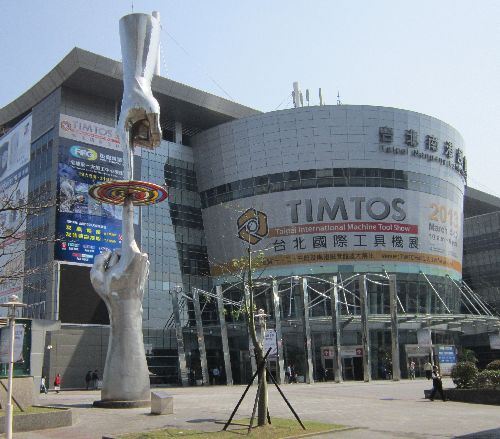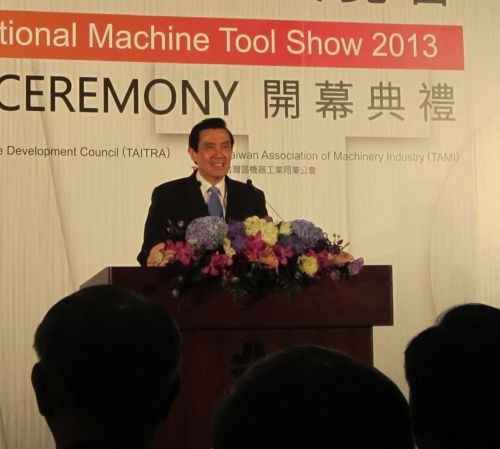Taiwan Eyes U.S. for Advancing Technology
Taiwan's machine tools are becoming more sophisticated, while the U.S. is becoming an increasingly important export market for the growing industry.
Share








Hwacheon Machinery America, Inc.
Featured Content
View More


Quality equipment and relatively low prices have traditionally made Taiwanese machine tools attractive in the U.S. market, but builders from the small island nation are increasingly touting another selling point: technological sophistication. My visit this past March to the Taipei International Machine Tool Show (TIMTOS), the biennial machine tool exhibition in the capital city, confirmed that these suppliers do indeed offer many of the features and capabilities valued by shops here in the States.
Likewise, while the United States traditionally has been an important market for Taiwanese suppliers, many exhibitors I visited said it has become even more so. The data confirm this. According to show organizers, exports to the United States increased 50.6 percent from 2011 to 2012, and America's 12.6 percent share of total exports is second only to China's. Other growth markets last year included third-ranking Thailand, with a 50.2-percent increase, Russia, with a 41.5-percent increase, and Canada, with a 96.2-percent increase, although all three combined still don't match the United States in terms of total exports.
The fact that Taiwanese builders export more than three quarters of their production underscores the importance of the U.S. market for growth--and growth has been the trend for the small island nation despite global economic uncertainty. Data from show organizers indicates that machine tool production increased by 5.2 percent from 2011 to 2012 to a total of $5.43 billion, while total exports increased 5.9 percent to $4.23 billion. And according to the latest World Machine Tool Output and Consumption survey (compiled by Modern Machine Shop publisher Gardner Business Media), Taiwan remained the world's sixth largest machine tool producer and fourth largest exporter in 2012.
TIMTOS is growing, too. Organized by the Taiwan External Trade Development Council (TAITRA) and the Taiwan Association of Machinery Industry (TAMI), the 24th iteration of the fifth largest machine tool exhibition in the world and second largest in Asia attracted 1,009 exhibitors occupying 5,400 booths. Those figures represent increases of 8.7 percent and 4.3 percent, respectively, compared to TIMTOS 2011. In total, the exhibition attracted an estimated 45,500 visitors, of which 5,500 hailed from abroad. In fact, the show lacked the space to accommodate more than 3,000 potential exhibitors (although a new exhibit hall expected to open in time for the 2015 show promises to help alleviate this concern).
While 2013 is expected to be positive, the industry still faces challenges. Uncertainties about exchange rates have led to uncertainties about the extent of this year's export growth, which show organizers have forecast at a broad range of 5 to 10 percent. Specifically, they cited concerns about the relative strength of the Taiwanese dollar versus its U.S. counterpart, as well as depreciation in two chief competitors' currencies: the Korean Won and Japanese Yen.
Regardless of what the future holds, most exhibitors I visited say they plan to continue to advance capabilities and to further differentiate and specialize their product lines. The show floor teemed with the results of their efforts thus far in this area. Here are a few trends I noticed at the show:
Complex Motion. Rare was the machining center supplier that didn’t offer a model with more than three axes, and most supplied equipment capable of full simultaneous five-axis moves. Increasingly, machine axes aren’t traversing via ballscrew, either—linear motors seemed ubiquitous on the show floor, appearing in equipment ranging from HMCs and VMCs to grinders and EDM equipment.
Multiple processes, one platform. Turn-mill machines were also a common sight at the show, and the range of offerings included more than just lathes with live milling and drilling tools. In addition to subspindles for part hand-off, notable offerings included machines with more than two turrets to balance production between the main and subspindle and Y-axes for off-center milling and drilling, among others. This trend extends beyond just turn-mills--one supplier, for instance, showcased a VMC with integrated laser marking.
Advanced control technology. More so than simpler configurations, five-axis and turn-mill machines depend on CNC features such as tool centerpoint control, robust simulation, machine monitoring and so forth. Taiwanese builders like YCM, Chevalier, Chmer and Tongtai, among others, are increasingly developing their own such features rather than sourcing from elsewhere.
Component suppliers step up. King Wang, chairman of TAMI's machine parts & elements committee, said Taiwan's machine parts and component industry has made considerable progress during the last few years. In fact, total export value for this sector amounted to nearly as much as machine tools themselves. Additionally, TIMTOS 2013 marked the first time that the Machine Tools Industry Awards for Excellence in Research and Innovation included a category specifically for machine components.
Click through this picture gallery for examples of these trends.
Read Next
Building Out a Foundation for Student Machinists
Autodesk and Haas have teamed up to produce an introductory course for students that covers the basics of CAD, CAM and CNC while providing them with a portfolio part.
Read More5 Rules of Thumb for Buying CNC Machine Tools
Use these tips to carefully plan your machine tool purchases and to avoid regretting your decision later.
Read MoreRegistration Now Open for the Precision Machining Technology Show (PMTS) 2025
The precision machining industry’s premier event returns to Cleveland, OH, April 1-3.
Read More























.png;maxWidth=150)



















